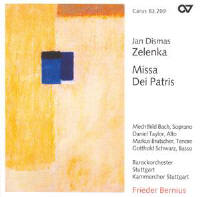Texte paru dans: / Appeared in: |
|
|
Reviewer: Michael
Carter
The stock of Jan Dismas Zelenka (1679-1745) has risen significantly in the last 20 or so years( N.B. Review published in 2002), and his advocacy by any number of performers and ensembles has begun to attract a growing number of followers who—like me—feel that the continuing exhumation of Zelenka's music reveals an exceptionally gifted minor master, if not a neglected genius. The resurrection of his liturgical works—some 150 in number—continues with each composition unfurling yet another aspect of this distinctive musical personality. Musicologists generally regard Zelenka's final three Masses—which he termed Missae ultimae—as his finest artistic achievements, and some even go so far as to place them on the same artistic and inspirational level as the Mass in B Minor of Bach. While I am neither qualified nor ready to place myself in the midst of that argument, I will confidently and unashamedly say that Zelenka's liturgical music is exceptionally crafted, revealing high degrees of competence and inspiration. Dating from 1740, Zelenka's Missa dei Patris is closer stylistically to the emerging gallant than the dying Baroque. However, the setting does follow the blueprint of the so-called "number" Mass in that the text of the various sections of the Ordinary is subdivided in such a way that large-scale choral passages alternate with expressive choral fugues and extended passages for one or more soloists. In spite of its massive proportions, the Missa dei Patris is an introspective, devotional, and economically scored work, employing only oboes and strings with the requisite continuo. Zelenka's Te Deum is the complete antithesis of the Mass: opulently scored for a festive orchestra and two choirs. Less introspective, it is as it should be: a veritable paean to the Creator of Mankind, complete with bustling string writing, the sweetness of flutes, the chattering discourse of oboes and bassoon, the brilliance of clarini, and the thunder of timpani. Soloists and choruses are employed and deployed with great skill and to an equally great effect, producing a canvas that is striking and artistically superior to those of many of Zelenka's contemporaries. The Mass of Johann David Heinichen (1683-1729) also draws upon the orchestral riches of the Elector's court, calling into play an ensemble of flutes, oboes, horns, trumpets, timpani, and the usual strings. Like Zelenka, Heinichen wrote prolifically for the Dresden Court Chapel, producing a brace of Requiems, a dozen Mass settings, more than 30 psalms, and a number of works for Holy Week. Like Zelenka, Heinichen chose the format of the "number" Mass, stitching together a series of exquisite miniatures that reveals the art of yet another minor master. The juxtaposition of solo, ensemble, and choir is effective, dramatic and even borders on the operatic. Carus is to be commended for its efforts on behalf of these composers. Only Zelenka's Missa dei Patris faces competition with Ludwig Güttier, I Virtuosi Saxoniae, and Thüringischer Akademischer Singkreis on Berlin Classics (1078). Guttler's recording is about a minute less in length than Bernius's Carus release, and Guttler doesn't seem as immersed in the message of the music as does Bemius. The result is a certain coldness that doesn't work for me. I prefer Bemius, who goes well beyond the printed page and as a result, produces a recording of devotion and beauty with moments of unsurpassed inspiration. Rademann also elicits fine performances that elevate the music to the plane of the sublime, indicating that his experience and insight far exceed his years. The Carus sessions display a youthful vigor that is perfectly offset by emotional and musical maturity seldom found in repertoire this far afield from the mainstream. The orchestral playing is confident and strong; the choirs light-voiced, yet resonant, and the soloists more than equal to their assigned tasks. Bemius, Rademann, and their charges are clearly committed to this repertoire, and if luck is at their side, there will be even more revelatory releases like this from the visionaries at Carus.
| |
|
|
|
|
|
|
|
Cliquez l'un ou l'autre
bouton pour découvrir bien d'autres critiques de CD |
|




